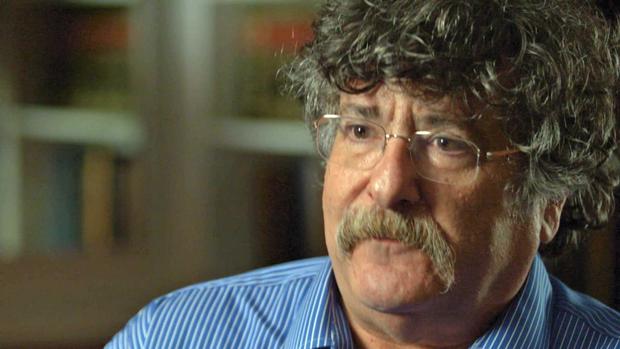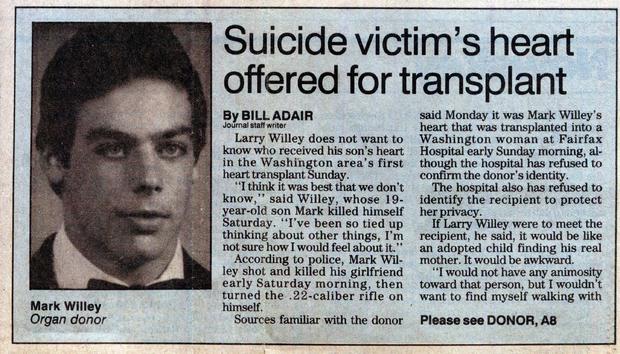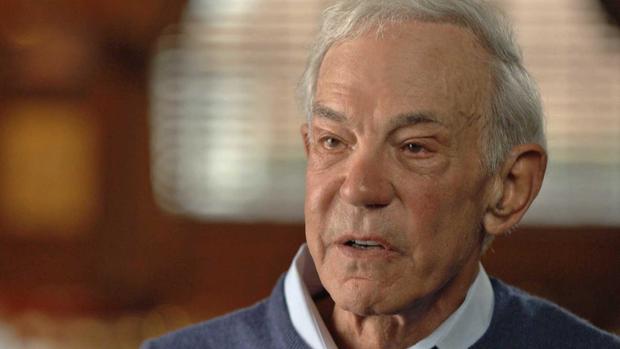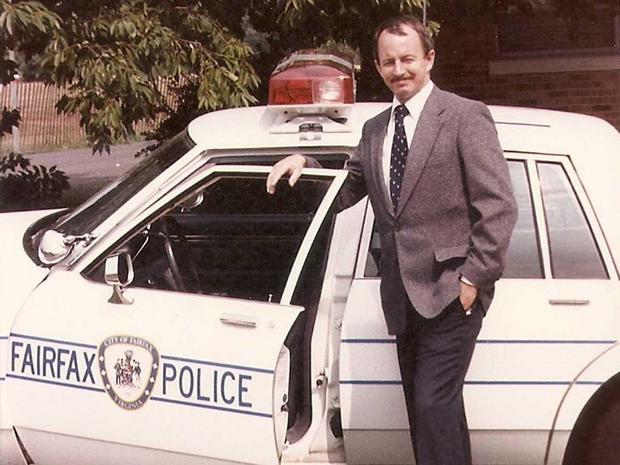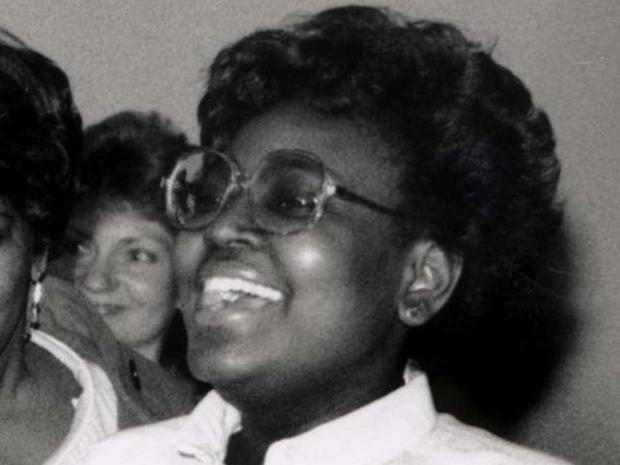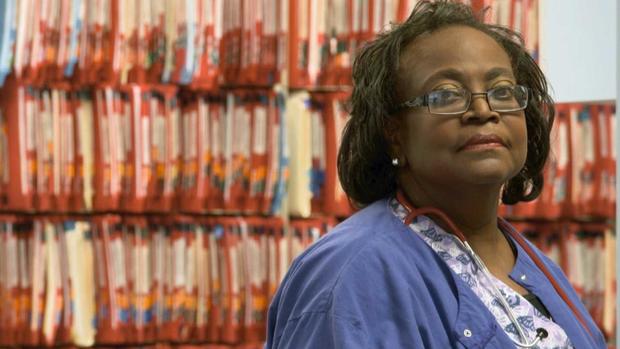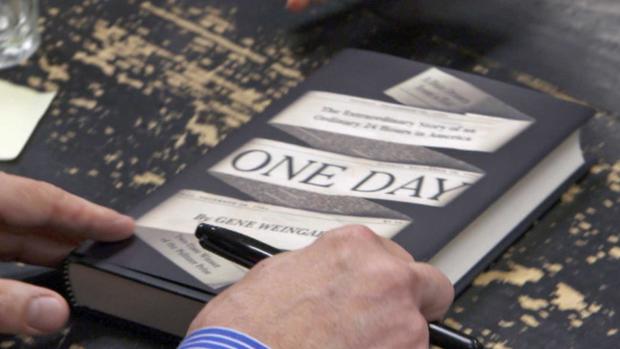Produced by Liza Finley and Richard Fetzer
Two-time Pulitzer Prize-winning writer Gene Weingarten has always believed there is no such thing as an ordinary day, so he set out to prove that theory by picking a random date out of hat. He ended up with December 28, 1986, and true to his belief, it encompassed the best and worst of the human experience.
NO ORDINARY DAY
If there are two things in this world that Washington Post Columnist Gene Weingarten loves, they are writing and tinkering with time.
Gene Weingarten [working on a clock]: This was made around 1895, and when I’m done with it, it’ll be working like new … When you’re repairing a really old clock. You feel as though you’re in touch with time itself.
Weingarten has long believed there is no such thing as an ordinary day, that countless stories lay hidden in space and time — some lost forever, other’s destined to be discovered.
Gene Weingarten: My theory has been that if you take a day, midnight to midnight … a single day … you would find encapsulated in that day the entire human experience. … And I decided to challenge that theory.
Jim Axelrod: How?
Gene Weingarten: By pulling numbers randomly out of a hat.
Weingarten and his editor, Tom Shroder, went to the Old Ebbitt Grill in Washington, D.C., threw 20 years of random dates into a green fedora, and picked one to prove Weingarten’s theory that something extraordinary happens every day.
Gene Weingarten: We came up with December 28, 1986.
It was the slowest news day of the week: a Sunday, during the slowest time of the year, the Christmas holidays.
Jim Axelrod: If we could’ve read that thought bubbles over both of your heads …
Gene Weingarten: You couldn’t print them. … we felt we had really drawn a terrible, terrible day….
But true to Weingarten’s theory, he’d soon learn this was no ordinary day. Something amazing had happened – a medical feat that would make history.
Gene Weingarten: Something astonishing happened … a remarkable triumph.
Gene Weingarten: And then I investigated further, and an entirely different story related to it emerged. … And that involved a savage murder, the murder of Karen Ermert.
Weingarten met a detective named Tommy Lee, who had held onto Karen’s file for 30 years for reasons he couldn’t quite explain.
Det. Tommy Lee: The case was closed, but I couldn’t just store her away … It bothered me that her life was cut short. I thank goodness for Gene Weingarten … because she’s going to have a little more of a legacy than just an obituary and a yearbook.
Jim Axelrod: Can you describe Karen for me a little bit?
Gene Weingarten: From a purely physical standpoint she was effortlessly beautiful. You look at her pictures and you just see someone who wasn’t trying to be pretty.
Gene Weingarten: She was talented. She played the flute. … and just everybody really loved her.
Including Rich Lieb.
Rich Lieb: I think about her all the time.
Lieb first met Karen in high school when she started dating another guy, his childhood friend, Mark Willey.
Rich Lieb: He … worshipped the ground she walked on. … there was just — a teenage boy that was really proud to be on the arm of a beautiful young girl.
But over time, Lieb – who double dated with Mark and Karen – says Mark’s pride turned to obsession.
Rich Lieb: If she wasn’t with him, he always wanted to know where she was … he actually, at times, drove around northern Virginia, following her to find out what she was doing and where she was.
Gene Weingarten: He was a young man who was furiously in love with a young woman. And I’m using the word furiously deliberately. He was what we would now call a stalker.
Jim Axelrod: This was a guy who had this beautiful teenage girl on his arm and lived in fear that he was going to lose her.
Rich Lieb: Oh, definitely … If she were somewhere, and somebody smiled, looked at her, and she smiled back, “What are you looking at them for?”
Jim Axelrod: This is not somebody who got a little too into his romantic partner. He wanted to own her.
Mark’s affection for whiskey made matters worse.
Rich Lieb: Soon as he started getting alcohol in him, he got paranoid, a little … defensive about every little thing, and really brooding and moody.
Jim Axelrod: He became a dark figure?
Rich Lieb: Yes, he was commonly known as an “angry drunk.”
And Karen was not one to back down from a fight.
Rich Lieb: They became very fiery together. He would start an argument … “Oh, he looked at you. You looked at him,” whatever. But she … would argue back. And I think … that just made him angrier.
Jim Axelrod: Rich, this is a combustible mix.
Rich Lieb: Yeah. Yeah, it really was.
Rich Lieb grew so disgusted by Mark’s behavior toward Karen he severed his friendship with Mark. But he would later learn just how combustible Mark and Karen’s relationship was.
Rich Lieb: She had gone to the hospital a number a times for injuries … she said that they would get into fights. And it was literally like a fist fight – that … she just had to try to defend herself. … that was very disturbing to hear that.
Gene Weingarten: He overwhelmed her over the years to the point where … she realized she could take this no more. And she broke up with him.
Around this time, Lieb received a letter that would change his life.
Rich Lieb: I got an anonymous letter … And it was a love letter.
Rich Lieb: I was just, “I don’t know who this is. I’d like to know who this is. But I have no idea.”
Jim Axelrod: Completely anonymous?
Rich Lieb: Completely anonymous.
Rich Lieb: It was obviously from someone who knew me … she thought that I was kind and considerate. … And she hoped that she could get up the nerve to — to tell me who she was.
Finally, she did.
Rich Lieb: Come Christmas day, I get a phone call. And it’s Karen. And she tells me … “I broke up with Mark. I’m in my apartment all by myself. My roommates are gone. Come over, keep me company.”
Rich Lieb “Sure.” Loved Karen. … great friends. So, I went over there. And — we spent a wonderful evening together, talking and just having a great time.
Rich Lieb: And about halfway through the night, she tells me, “Did you get a letter couple months ago?” And I was just floored. I had no idea. … And — she told me that she’d always had feelings for me … and we just fell right into step.
Jim Axelrod: If I inject you a truth serum on the night of the 26th, you think you’ve found your life partner?
Rich Lieb: Yeah, probably. … Can’t help but wonder what might have been.
Gene Weingarten: It was like a revelation to her, as sad as this sounds, that you could have a romantic relationship that didn’t cause pain. She hadn’t known that.
But Mark Willey refused to let her go, says Lieb, who was there when Karen called Mark to tell him there was no chance of getting back together.
Rich Lieb: Basically, it was, “Look, I’ve tried to tell you nicely. I’ve tried to explain it to you. I’ve tried to be gentle about it, but we’re through. I’m not gonna put up with your abuse anymore. … and I don’t wanna see you anymore.”
Jim Axelrod: What did you hear?
Rich Lieb: Just a – raised voice – angry, raised voice. But she was smiling. And I think she felt a huge sense of relief to finally felt like, “I’m done with this.”
Gene Weingarten: Nobody really caught the pure horror of this breakup. He told her at the time he was going to kill her … she laughed. She didn’t think this was going to be possible.
FROM TRAGEDY … TO TRIUMPH
Rich Lieb will never forget the last time he saw Karen Ermert. He was saying goodbye before leaving on a one-day ski trip
Rich Lieb: And I told her, “I really don’t wanna go. I just wanna spend the time with you.” But I already made an obligation. “They’re expecting me …” And she said, “OK, I’ll see you tomorrow?” I said, “Sure. I will call you as soon as I get in.” And we parted ways.
Neither one imagined Karen’s estranged boyfriend Mark Willey was making plans of his own.
Jim Axelrod: He was either going to be able to get back together with this woman he had this obsession about, or he was going to kill her.
Det. Tommy Lee: That’s correct.
Armed with a bottle of whiskey and a .22 caliber rifle, Mark Willey got into his car and headed to Karen’s apartment.
Gene Weingarten: Mark was in a rage. … obviously he’s not thinking clearly. Karen had every right to break up with him. She almost had an obligation to break up with him.
Jim Axelrod: So, he’s got a bunch of rage.
Det. Tommy Lee Yes, he does.
Jim Axelrod: He’s got a bunch of booze.
Det. Tommy Lee: Yes.
Jim Axelrod: And he’s got a rifle.
Det. Tommy Lee: Yes.
Jim Axelrod: Awful combination.
Det. Tommy Lee: Deadly one.
DECEMBER 27 | 2 A.M.
Jim Axelrod: So, take me through it. He shows up here, he doesn’t go in through the front door.
Det. Tommy Lee: No. He parks his car around the other side … walks over here [points to the back of the building].
Gene Weingarten: He climbed up a tree to a balcony near her bedroom. He apparently had the rifle on his back. He stowed it on the balcony, walked into the house.
Detective Lee believes it was Mark’s last-ditch effort to win her back.
Det. Tommy Lee: And they got into a rather heated argument. And I think it was at that time that he decided that it’s not going to work out. … And he goes back out and gets the .22 and shoots five rounds — killing her.
Rich Lieb got the news when he returned from his ski trip.
Rich Lieb: I walk in the door, drop my stuff, immediately go to pick up the phone. And my mother comes in and stops me from dialing. And says, “Rich – Karen was shot last night.” And I’m just in shock. “Oh my gosh, what hospital? Where’s she at?” “She didn’t make it.”
And this is the part of the story where out of something horrifying came something amazing says Weingarten. The part of the story that belonged to a young woman named Eva Baisey, a very sick 20-year-old nursing student fighting for her life in Fairfax hospital. A couple of months earlier, the single mother of two young children had suddenly fallen ill.
Gene Weingarten: She couldn’t walk more than a half block without stopping and wheezing. Climbing a set of stairs had become a Himalayan task for her. Her own doctor felt she had possibly a month or two to live.
Gene Weingarten: She finally went to see a heart specialist. And the heart specialist did some tests and said, “I need to put you in touch with a man I know.” And it was Dr. Lefrak.
When Dr. Ed Lefrak, chief of Cardiac Surgery at Fairfax Hospital in Virginia, met Eva Baisey, she was suffering from idiopathic cardiomyopathy.
Dr. Ed Lefrak: The idiopathic means we have no idea what caused the heart failure. Her heart began to fail.
Dr. Lefrak knew she would not survive without a radical procedure: a heart transplant. There was just one hitch.
Jim Axelrod: Had you ever performed a heart transplant before?
Dr. Ed Lefrak: No, I had not.
In 1986, heart transplants were so uncommon, no hospitals in the greater Washington D.C. area were legally allowed to perform them. Dr. Lefrak — determined to make Fairfax the first – fought relentlessly to get permission. But the local health agency said no; there wasn’t enough demand.
Jim Axelrod Some people might hear the “no” and go away.
Dr. Ed Lefrak: That’s not how I roll … it’s just the opposite.
Mary Dellinger was Lefrak’s surgical nurse.
Mary Dellinger: He was very determined, and he wouldn’t take no for an answer.
Lefrak hatched a plan: to bring the man who performed the first-ever successful heart transplant in 1967 – celebrated on the cover of Time magazine – Dr. Christiaan Barnard to lobby the state health commissioner on Lefrak’s behalf.
Gene Weingarten: He arrived in Virginia like a superstar … He said it would be amoral to not permit a qualified surgeon like Dr. Lefrak to do this surgery. And instantly, they got permission.
Mary Dellinger: Dr. Lefrak just came in the O.R. the next day and he says, “We got it.”
Jim Axelrod: What were you thinking?
Mary Dellinger Well, I was thinking, “OK, we’re on … now we need to find the first perfect patient.”
That first perfect patient was Eva Baisey. But she was running out of time.
Gene Weingarten: Eva was dying. She was getting sicker and sicker.
Deirdre Carolan Doerflinger was Eva’s primary care nurse.
Deirdre Carolan Doerflinger: It was a very real possibility that she could die before she got a heart. Many people do.
DECEMBER 27
Not knowing when or if a donor would come through, Dr. Lefrak sent his wife, Trudy, and their four girls on a family holiday trip without him. He only had one thing on his mind.
Jim Axelrod: Dr. Lefrak and his team – they’re looking for a heart.
Gene Weingarten: They have somebody to save.
And then it came. The call they’d been waiting for.
Jim Axelrod: It’s a go.
Mary Dellinger: It’s a go.
A PERFECT DONOR
Dr Lefrak and his team were getting ready to make history — about to become the first team in the Greater D.C.-area to attempt a heart transplant. They had finally found the perfect donor for Eva Baisey.
Jim Axelrod: Did you know anything about the donor at that point?
Dr. Ed Lefrak: No. I really did not know anything about the donor. I think they called me and told me it was a donor with a gunshot wound to the head.
But it wasn’t Karen Ermert.
Gene Weingarten: In the perfect narrative, Karen Ermert’s heart would’ve been the one that saved Eva Baisey, but that’s not how it happened. Things are not always that simple. It was the killer’s heart that saved Eva Baisey.
December 27 | 2:00 am
After Mark Willey shot his ex-girlfriend Karen Ermert dead, he paused.
Gene Weingarten: He waited in the house until the police arrived and started knocking on the door … And then he shot himself in the forehead.
Jim Axelrod: So, if the relationship was over then life was going to be over —
Det. Tommy Lee: Yes.
Jim Axelrod: — for both Karen and him.
Det. Tommy Lee: That’s correct.
Mark Willey was declared brain dead. But his heart was still beating.
Jim Axelrod: How was it still beating?
Gene Weingarten: The bullet passed through both hemispheres of the brain. Somehow, when that happens, often — but not always — the heart keeps beating.
Jim Axelrod: By the time you arrive at this apartment, he’s gone.
Det. Tommy Lee: Yes.
Jim Axelrod: He’s been transported to the hospital?
Det. Tommy Lee: Yes.
His body was rushed to the same hospital where Eva Baisey lay dying, as the transplant coordinator sought permission from Mark’s parents to donate their son’s still beating heart.
Mark’s father, Larry Willey, gave a brief, voice-only statement to local media:
LARRY WILLEY: Two families have suffered a terrible tragedy. One that can never be totally healed … Hopefully something good can come out of this tragedy.
Gene Weingarten: They were good people. They were horrified. They were in grief. And, you know, they made the right call.
DECEMBER 28, 1986 | 2:30 A.M.
Eva Baisey was wheeled down to Operating Room 6.
Deirdre Carolan Doerflinger: I said a prayer for her. I’m a firm believer in prayer. … We’re excited for her, but we’re also terrified. I mean, she could die downstairs.
Dr. Lefrak and his team gathered in Operating Room 12 to remove – for the first time – a living, beating heart.
Gene Weingarten: They had been working with corpses in the morgue because … heart transplantation was not taught in colleges, in medical schools at the time. The only way to learn it was to do it.
Dr. Ed Lefrak: I would do a regular heart operation in the morning. And in between operations — go to the morgue with a team … And then go back to the operating room.
Jim Axelrod: Doctor, you were learning how to perform heart transplants on your lunch hour?
Dr. Ed Lefrak: Yeah, I guess you could say that [laughs].
But this time, it was for real.
Jim Axelrod: As ready as you were, was any part of you, at all, a little scared?
Dr. Ed Lefrak: No, not at all … I felt totally comfortable … ’cause I had done this many times in the morgue.
Jim Axelrod: You play like you practice?
Dr. Ed Lefrak: Exactly, yeah.
Dr. Lefrak began to remove the donor heart.
Gene Weingarten: Lefrak is a man with a pair of scissors. … And he essentially cut it out of that body with scissors that aren’t very different from what a second grader would use to cut colored paper. They are just scissors.
Dr. Ed Lefrak [with a model of a heart]: We cut, cut, cut, cut … cut the aorta. Cut the pulmonary artery. And then the heart is free.
Dr. Ed Lefrak: Taking a heart out of a donor takes 5 minutes.
Jim Axelrod: Five minutes?
Dr. Ed Lefrak: … it’s really easy.
Dr. Ed Lefrak: So, we take it out, cold, because we put cold solution in it. And then immediately put it in bags with ice.
The heart, which ideally shouldn’t stay outside the body more than four hours, was bagged and put into an Igloo cooler — the same kind you buy at the supermarket.
Mary Dellinger: When we were gathering all our supplies, it was like, well, “who’s got a cooler?” I said, well, “I’ve got an Igloo cooler.”
Jim Axelrod: So, you brought your cooler in from home.
Mary Dellinger: I brought my cooler in from home. I still have that cooler.
The cooler with the heart was carried 90 feet down the hall, from O.R. 12 to O.R. 6, Eva’s room.
Jim Axelrod: What was the mood like in O.R. 6?
Mary Dellinger: I think it was a real high sense of anticipation … “Oh, my gosh, we’re really doing this.”
Jim Axelrod: Twelve is trauma and despair. Six is hope.
Mary Dellinger: Hope, yeah. Absolutely. And you know that we’re fixing somebody.
Dr. Lefrak began replacing Eva’s dying heart with the healthy one.
Jim Axelrod: You remove Eva’s heart … And now what?
Dr. Ed Lefrak: Once it’s out, now we take the donor heart out of the cooler. And – have to do a little preparing on it to sew it into … this big empty space, which is quite a dramatic scene. There’s a person lyin’ there on the operating table, Eva, with her chest open and no heart.
Dr. Ed Lefrak: And she is alive because she’s getting circulation through the heart, lung machine.
He began to sew the new heart into Eva’s chest.
Dr. Ed Lefrak [with a model of a heart]: The back wall of Eva’s heart was left in place. That makes it much easier to sew the donor heart to Eva.
After about 45 minutes, the new heart was in Eva Baisey’s chest. Now came the moment of truth.
Gene Weingarten: Usually you need an electric shock … You have those paddles that you use. In this case, there was like this odd alchemy and the heart just started beating.
Jim Axelrod: That must have been –
Mary Dellinger: It was incredible.
Dr. Ed Lefrak: Exhilarating, and very rewarding … I get tearful if I even say it.
Jim Axelrod: And is that the moment you think to yourself, “Did it”? [laughs]
Dr. Ed Lefrak: Well, I don’t usually think like that. Because it’s not over til it’s over, til she goes home.
EVA’S NEW HEART
The Karen Ermert murder case was closed; the killer was dead. But Detective Tommy Lee couldn’t let it go.
Det. Tommy Lee: Every detective has a case that haunts you … and this case will haunt me until the day I die.
Detective Lee went to Karen’s funeral.
Jim Axelrod: You didn’t know her.
Det. Tommy Lee: No, but I had some time with her mother … It would have been wrong for me not to go pay respects to Karen whose life was cut so short.
Gene Weingarten: There’s no way you can wipe away … the central tragedy of this story. A deeply disturbed man killed an innocent young woman. … You can only move on from it and say something positive happened as a result
DECEMBER 29, 1986
NEWS REPORT: The Washington area’s first heart transplant case is a dramatic story of one District woman’s life renewed. A 20-year-old mother of two is in stable, but serious condition in Fairfax Hospital tonight.
It was huge news. The first heart transplant recipient in the greater Washington, D.C.-area had made it through the operation.
Deirdre Carolan Doerflinger | Eva Baisey’s primary care nurse: It’s a miracle. It’s a miracle. … I was very touched and happy by the fact that she was doing well and had gotten through the surgery.
Finally, Eva Baisey opened her eyes.
Eva Baisey | Heart transplant recipient: I just woke up. Like I just went to sleep that night and like any other night, you know. I had forgotten that I was sick when I woke up.
Eva Baisey: And I just wanted to go home the next day. I’m like, “Can I go home, I’m ready.”
Jim Axelrod:: Meanwhile, they’re like what part of transplant didn’t you understand.
Eva Baisey: Exactly. Yes [laughs].
She didn’t know it, but the hardest part was still to come. The fight against her body’s natural instinct to reject her new heart.
Mary Beth Maydosz | Transplant coordinator: Their body never, never accepts that heart as their own. It’s always somebody else’s genes, so we have to fool it always.
The way to fool the body is with anti-rejection drugs. And since Eva was patient No. 1, Dr. Lefrak was teaching himself all about it. It was a delicate balancing act of suppressing her immune system to prevent rejection without leaving her too vulnerable to infection.
Dr. Ed Lefrak | Transplant surgeon: It was quite a while she was in the hospital.
Deirdre Carolan Doerflinger: I think every time Eva had rejection I was worried that we would lose her. Because her rejections were quite severe sometimes.
Eva was quarantined to guard against infection.
Mary Beth Maydosz: You looked like from the movies now, where people go into the room where someone has Ebola or something. You know, we put booties on and the head coverings and gowns and everything just to go into the room. She must have felt so isolated and scared in there.
Eva Baisey: It was it was difficult. That was the hardest … I want to see my babies. They would let my mom come in, and she had to stand in a corner for 5 minutes with a mask on and gloves, you know.
Jim Axelrod: So, you couldn’t hug?
Eva Baisey: No, no.
As the weeks ticked by, Eva seemed to be doing well medically, but struggled in her small, lonely world, says Doerflinger, who was one of her few connections to the outside.
Deirdre Carolan Doerflinger: Very lonely. That’s why I used to stay after sometimes and just sit with her so that she had some company, I mean … We’d try and bring her in things if she wanted it. Or, you know, we’d get her stuff from home and bring it in. We did whatever we could to keep her more comfortable. … Eva was particularly upset one day … And she said, “I just — I wanna get outta here. … I wanna breathe fresh air.”
So, Doerflinger devised a plan. She carefully cleaned her car, put Eva in a mask and gloves, and the two hit the road.
Deirdre Carolan Doerflinger: We just went out for a drive.
They even stopped at McDonalds.
Deirdre Carolan Doerflinger: She got a hamburger and I think a Coke or something. And she wanted French fries. I think we ditched the French fries. I said, “Let’s not push it [laughs]. I’d like to keep my job.”
Jim Axelrod: God bless Deirdre, huh?
Eva Baisey: Yeah. And oh, my God, it was the best burger I have ever had.
Dr. Lefrak had reluctantly agreed to the outing, but Doerflinger and Eva kept the fast food part a secret.
Dr. Ed Lefrak: I mean, we gave her guidelines, but she wasn’t a big guideline person [laughs].
It turns out that the transplant transformed more than just the patient.
Jim Axelrod: Surgeons aren’t usually known for their bedside manner.
Eva Baisey: Yeah, that’s how he was in the beginning.
Jim Axelrod: In the beginning —
Eva Baisey: Yes. … He’s very quiet. “Hi, Eva. I’m going to inject this into you.” And, “Bye, Eva” … Straight to the point and get out my room.
Jim Axelrod: How did that relationship evolve?
Eva Baisey: I think that he was happy that it was a success. … So, he became a little more open … And then eventually, he’s, you know, just came out of his shell.
Dr. Ed Lefrak: I learned to love Eva and accept all parts of her.
Jim Axelrod: “I love you” is not standard operating procedure between a surgeon and patient.
Dr. Ed Lefrak: No, I don’t think I’ve ever had that kind of relationship with any other patient.
Dr. Lefrak wasn’t the only one falling under Eva’s spell.
Mary Beth Maydosz: She’s so thankful and kind. You feel appreciated, so you appreciate back.
February 14, 1987
Nearly two months after being wheeled in so close to death, Eva Baisey was finally given the OK to walk out the hospital doors.
Deirdre Carolan Doerflinger: The day she was ready to go home … The whole team was there to say goodbye to Eva. And her mom was there.
EVA’S MOTHER | LOCAL NEWS REPORT: I just want to thank everybody for helping my daughter… it’s been so beautiful.
Deirdre Carolan Doerflinger: It was a wonderful time. I mean, that was so exhilarating to see her go out that door. And to know … She had gotten through this.
Jim Axelrod: Did you allow yourself a moment when she did go home to think to yourself, “I have now accomplished a heart transplant”?
Dr. Ed Lefrak: Yeah, the was a good day. I can picture exactly her getting into the car.
Patient No. 1 went home, but it would be years before she’d learn the whole story behind her new heart.
SURPASSING EXPECTATIONS
Eva Baisey finally went home, but life was not the same. At first, she could only see her kids an hour a day due to the risk of infection. And she was told she could never work as a nurse.
Gene Weingarten: Doctors were concerned that she would be susceptible to disease if she worked around sick people.
Jim Axelrod: The procedure that saved her life was going to cost her her job.
Gene Weingarten: More than her job. It was going to cost her her dream. She wanted to work with babies and old people.
Instead, Eva concentrated on raising her two children, Shakeyta and Antonio.
Antonio Baisey: She always asked the Lord to just let her see us make it until 18. So, I think that that was her main drive behind stayin’ alive … was her kids.
Stay alive she did, surpassing all expectations.
Mary Beth Maydosz | Transplant coordinator: We thought transplant … people were going to live five years. … I think it was actually a shock to her, after five years, that we said to her, you know, “You’re still here, maybe you need to get a job [laughs].”
Dr. Lefrak agreed. Eva was doing so well he changed his mind. She could work in healthcare after all. She has been helping sick people deal with their health problems ever since.
Eva Baisey: I’ll … tell them my story about my — you know, the transplant. I say, “things are not always going to be like this. I promise you they will get better.” And they do.
Eva continued to defy the odds: five years became 10, 10 became 15, and 15 became 30.
DECEMBER 28, 2019
Dr. Lefrak [On phone with Eva]: Happy December 28th!
On December 28, 2019, Dr. Lefrak made the call he has made on that date every year since the transplant.
Jim Axelrod: What do you say to each other in that anniversary phone call?
Dr. Ed Lefrak: Well, I congratulate her and usually tell her that I love her.
Dr. Lefrak [On phone with Eva]: I’ll keep in touch with you, Eva. I love you and you know it.
Jim Axelrod: So, this isn’t just your doctor.
Eva Baisey: No, he’s my friend … I still call him Dr. Lefrak. But he’s my friend now. Yeah, I love him. I love him dearly.
And the feeling is quite mutual.
Jim Axelrod: What is that all about?
Dr. Ed Lefrak [emotional]: I don’t know. I just — I respect her and, you know – get teary — sorry. But I just I just love her. I don’t know what it’s about. Just really appreciated her. And it’s all — it’s all good. I just hope she lives forever.
Eva Baisey – who had a life expectancy of one to five years, is now one of the longest living heart transplant recipients in medical history. Twenty years is considered great. Eva just celebrated her 33rd anniversary.
Jim Axelrod: Why do you think she’s doing so well? Why has she done so well and lived so long?
Mary Beth Maydosz | Transplant coordinator: Some of it is luck, and a lot of it is tenacity. … She’s really sweet, but if she didn’t have a certain amount of tenacity, backbone and grit, she wouldn’t have gotten out 33 years.
Dr. Lefrak retired 10 years ago, celebrating with his five daughters. He happily tossed his pager into the Potomac, toasting a next chapter he was determined to make great.
At 76, he recently rode in a 100-mile bicycle race, the heart transplant program he started continues to thrive, and so is his message — best summed up by patient No. 1.
Eva Baisey: It’s OK to let a loved one’s organs be donated to help someone else’s loved ones.
Eva Baisey: I was naïve to donation until it actually happened to me. And I think a lot of us are until we actually know someone. Now I’m Eva and you know me. It works.
Eva Baisey never knew the whole truth about the heart that saved her life. It wasn’t until Gene Weingarten published his book “One Day” that she learned the full story. A story that led back to that senseless murder of Karen Ermert by her estranged boyfriend Mark Willey.
Jim Axelrod: Do you ever think about her, Karen? Now that you know a little bit more since Gene wrote the story?
Eva Baisey: I do now. Yes. … would she be a mom? Would she have grandkids? I think about her a lot now.
Jim Axelrod: If you could speak to Karen’s family, what would you want to say to them?
Eva Baisey: I’m sorry. Thank you.
Jim Axelrod: You know, in the movie version, you get her heart. And in real life, you got his heart.
Eva Baisey: Mm hmm.
Jim Axelrod: Does it make any difference to you?
Eva Baisey: No. It’s just — it’s a heart. It’s an organ. It’s not a murder organ. And it’s just an organ that happened to save my life.
Jim Axelrod: And the story here is what the person who received the organ does with the extra years she then gets?
Eva Baisey: That is correct.
Jim Axelrod: When you heard … this woman, Eva Baisey, got a heart, and she’s still alive 33 years later … does that help you make any sense of what happened?
Rich Lieb: It does. It really does. It lightens my soul to know that somebody got a second chance at life out of the tragedy that happened.
And, so it seems, Gene Weingarten was right. There is no such thing as an ordinary day — no way to make sense of who lives and who dies at any given time. Perhaps all we can do is treasure the memories of those now gone and thank the heavens — and in this case, a team of extraordinary doctors and nurses — for those who still walk among us.
Eva Baisey: And I’m still here, you know, and I just — how blessed I am.
To sign up to be an organ donor visit the National Donate Life Registry at Registerme.org.

